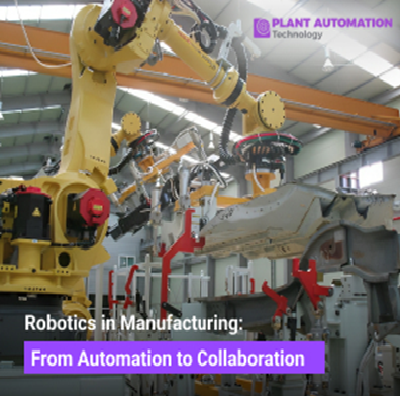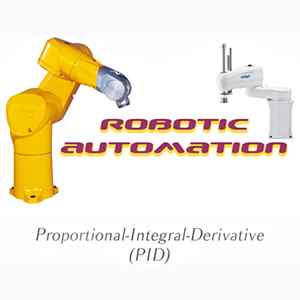Robotics in Manufacturing: From Automation to Collaboration

Introduction
The manufacturing sector has undergone a substantial transformation over the years, with robotics playing a crucial role in driving this evolution. Initially, automation in manufacturing centered on the use of robots for repetitive and hazardous tasks. However, in the present day, we are experiencing a new era of manufacturing where humans and robots collaborate seamlessly. This article delves into the evolution of robotics within the manufacturing industry, emphasizing the transition from conventional automation to collaborative robotics and the profound consequences of this transformation.
A) Manufacturing Automation
Automation has remained a prominent concept in the manufacturing industry for many years. It encompasses the utilization of machinery, robots, and computer systems to manage responsibilities that were traditionally carried out by human labor. The core purpose of automation is to enhance efficiency, minimize errors, and boost overall productivity.
In the early stages of automation, industrial robots were introduced to carry out repetitive and labor-intensive tasks such as welding, painting, and material handling. These robots were designed to work in isolation, away from human workers, in controlled environments. While they were successful in increasing productivity and precision, they lacked the ability to adapt to dynamic manufacturing environments and collaborate with human workers.
B) Emergence of Collaborative Robotics
With the increasing complexity and adaptability of manufacturing processes, a demand arose for robots capable of collaborating with human operators. This gave rise to the creation of collaborative robots, commonly known as "cobots." Cobots are specifically engineered to engage with and support human workers within a shared workspace, as opposed to substituting for them. They are outfitted with advanced sensors and safety measures to ensure secure and effective cooperation.
C) The key characteristics of collaborative robots include:
Safety: Cobots are equipped with sensors that can detect the presence of humans and automatically stop or slow down their movements to prevent accidents. This makes them suitable for tasks that require close human-robot interaction.
Flexibility: Unlike traditional industrial robots, which are often fixed in place, cobots are portable and easy to reprogram for different tasks. They can quickly adapt to changing production needs, making them highly versatile.
Ease of Use: Cobots are designed to be user-friendly, with intuitive interfaces that allow non-experts to program and operate them. This reduces the barrier to entry for small and medium-sized manufacturers.
Cost-Effective: Collaborative robots are generally more affordable than their industrial counterparts, making automation accessible to a wider range of businesses.
D) Applications of Collaborative Robots in Manufacturing
Collaborative robots have found applications in various sectors of manufacturing, including:
Assembly: Cobots are used for assembling products, where they can work alongside human workers to complete intricate tasks, ensuring high precision and speed.
Inspection and Quality Control: Cobots equipped with cameras and sensors can perform quality control checks on products, identifying defects and inconsistencies in real-time.
Material Handling: Collaborative robots possess the capability to lift substantial loads and move materials throughout a factory, mitigating the potential for injuries among human workers.
Packaging and Palletizing: Cobots can package products and arrange them on pallets, improving the efficiency of the packaging process.
Welding and Machining: In some cases, cobots are employed for welding and machining tasks, particularly in smaller-scale manufacturing operations.
E) Benefits and Implications of Collaborative Robotics
The adoption of collaborative robots in manufacturing has brought about several benefits and implications:
Improved Efficiency: Cobots can work continuously without fatigue, leading to increased productivity and reduced cycle times.
Elevated Safety: The advanced safety features of cobots substantially diminish the probability of workplace accidents and injuries.
Workforce Augmentation: Collaborative robots complement human skills rather than replace workers, leading to improved job satisfaction and better utilization of human resources.
Scalability: Small and medium-sized businesses can benefit from automation without significant upfront costs, as cobots are often cost-effective and easy to integrate into existing processes.
Adaptability: Cobots can be reprogrammed and redeployed for different tasks, making them suitable for industries with changing production demands.
F) Challenges and Considerations
While collaborative robots offer numerous advantages, there are also challenges and considerations to be aware of:
Integration Complexity: Integrating cobots into existing manufacturing processes may require expertise and investment in training and infrastructure.
Cost of Ownership: While cobots are more affordable upfront, the total cost of ownership, including maintenance and programming, should be carefully evaluated.
Job Displacement Concerns: Despite the collaborative nature of cobots, there are concerns about potential job displacement in the long term. However, many argue that cobots can enhance job roles and create new opportunities.
Technical Limitations: Collaborative robots may not be suitable for all manufacturing tasks, especially those that require extreme precision or heavy lifting beyond their capacity.
G) Future Trends in Collaborative Robotics in Manufacturing
As collaborative robotics continues to evolve, it opens up new horizons for manufacturing. Here are some additional insights into the future of robotics in manufacturing:
Integration of Artificial Intelligence: Collaborative robots are progressively being outfitted with artificial intelligence (AI) functionalities. This empowers them to execute more intricate tasks and adjust to dynamic surroundings. AI-driven cobots have the capacity to make real-time decisions, optimize operations, and gain insights from their interactions with human workers, further enhancing their value in the realm of smart manufacturing.
Human-Robot Symbiosis: The future holds the promise of deeper human-robot collaboration, where humans and robots work together seamlessly as symbiotic teams. This involves a high degree of trust and coordination between humans and cobots, leading to improved efficiency and creativity in problem-solving.
Customization and Small-Batch Production: Collaborative robots are well-suited for small-batch production and customization. In an era where consumers increasingly seek personalized products, cobots can help manufacturers meet these demands efficiently by quickly reconfiguring themselves for different tasks and product variations.
Cross-Industry Adoption: The use of collaborative robots is not limited to traditional manufacturing sectors. Industries such as healthcare, logistics, and agriculture are also exploring the benefits of cobots. In healthcare, for instance, they can assist in surgeries and patient care, while in logistics, they can streamline warehouse operations.
Sustainability and Resource Efficiency: Collaborative robotics can play a pivotal role in sustainable manufacturing. They can optimize resource usage, reduce waste, and lower energy consumption through precise control and real-time monitoring.
Conclusion
The evolution of robotics in manufacturing, progressing from pure automation to collaborative efforts, has brought about a profound revolution in the industry. Collaborative robots, known for their safety features, adaptability, and cost-effectiveness, have democratized automation, making it accessible to a wider array of manufacturers. They hold the potential to enhance efficiency, improve safety standards, and complement the workforce, leading to increased productivity and competitiveness within the manufacturing sector. However, achieving successful integration requires meticulous consideration of technical, financial, and human factors. With the continued advancement of technology, the role of collaborative robotics in manufacturing is poised to expand further, shaping the industry's future.







